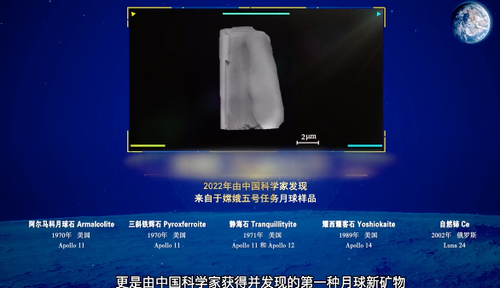
One day after Chinese state media published a story about discovering a new phosphate lunar mineral, China National Space Administration (CNSA) (equivalent to NASA) released a mission timeline for future moon exploration trips.
On Friday, state media outlet Global Times announced that lunar samples collected in 2020 during the Chiang'e-5 million contained a small amount of a new lunar mineral called "Changesite-(Y)" in rock and dust samples.
The single crystalline particle measured around 10 microns in diameter - or around one-tenth of a human hair, according to SCMP, citing Chinese official Wang Xuejun of the China National Nuclear Corporation (CNNC)
A new mineral, Changesite-(Y), was discovered from the moon samples retrieved by #China's Chang'e-5 probe, making China the third country to discover a new mineral on moon, Chinese authority said on Friday. pic.twitter.com/XjatWOtraY
— Global Times (@globaltimesnews) September 9, 2022
Changesite-(Y) is a phosphate mineral found in lunar basalts. The discovery of the new mineral was confirmed by Commission on New Minerals, Nomenclature and Classification of the International Mineralogical Association.
"[The discovery] provides more basic scientific data for the evaluation and development of lunar resources and has deepened mankind's knowledge of the moon and the solar system," Dong Baotong, vice-chairman of the China Atomic Energy Authority (CAEA), said.
Separately, the lunar sample also contained helium-3, a rare element on earth that it known to be abundant on the moon. The isotope has a wide variety of uses - including as a potential fuel source.
Xuejun said the findings within the 2020 sample "provides fundamental scientific data for future assessment of Helium-3 in lunar samples and their exploration."
Following the announcement, Liu Jizhong, an administrator with the China Lunar Exploration and Space Program Center, was quoted by state media outlet CCTV as saying three lunar orbiters would be sent to the moon in an accelerated exploration program over the next year years.
So what's so special about Helium-3?
The European Space Agency (ESA) explained the idea of mining a "clean and efficient form of energy from the Moon" is entirely possible because the lunar surface has "large quantities of Helium-3."
"It is thought that this isotope could provide safer nuclear energy in a fusion reactor, since it is not radioactive and would not produce dangerous waste products," ESA continued.
The race to mine the moon and extract all sorts of minerals is well underway, and China is proving that. We have pointed out mining could start as early as 2025.
One day after Chinese state media published a story about discovering a new phosphate lunar mineral, China National Space Administration (CNSA) (equivalent to NASA) released a mission timeline for future moon exploration trips.
On Friday, state media outlet Global Times announced that lunar samples collected in 2020 during the Chiang’e-5 million contained a small amount of a new lunar mineral called “Changesite-(Y)” in rock and dust samples.
The single crystalline particle measured around 10 microns in diameter – or around one-tenth of a human hair, according to SCMP, citing Chinese official Wang Xuejun of the China National Nuclear Corporation (CNNC)
A new mineral, Changesite-(Y), was discovered from the moon samples retrieved by #China‘s Chang’e-5 probe, making China the third country to discover a new mineral on moon, Chinese authority said on Friday. pic.twitter.com/XjatWOtraY
— Global Times (@globaltimesnews) September 9, 2022
Changesite-(Y) is a phosphate mineral found in lunar basalts. The discovery of the new mineral was confirmed by Commission on New Minerals, Nomenclature and Classification of the International Mineralogical Association.
“[The discovery] provides more basic scientific data for the evaluation and development of lunar resources and has deepened mankind’s knowledge of the moon and the solar system,” Dong Baotong, vice-chairman of the China Atomic Energy Authority (CAEA), said.
Separately, the lunar sample also contained helium-3, a rare element on earth that it known to be abundant on the moon. The isotope has a wide variety of uses – including as a potential fuel source.
Xuejun said the findings within the 2020 sample “provides fundamental scientific data for future assessment of Helium-3 in lunar samples and their exploration.“
Following the announcement, Liu Jizhong, an administrator with the China Lunar Exploration and Space Program Center, was quoted by state media outlet CCTV as saying three lunar orbiters would be sent to the moon in an accelerated exploration program over the next year years.
So what’s so special about Helium-3?
The European Space Agency (ESA) explained the idea of mining a “clean and efficient form of energy from the Moon” is entirely possible because the lunar surface has “large quantities of Helium-3.”
“It is thought that this isotope could provide safer nuclear energy in a fusion reactor, since it is not radioactive and would not produce dangerous waste products,” ESA continued.
The race to mine the moon and extract all sorts of minerals is well underway, and China is proving that. We have pointed out mining could start as early as 2025.





